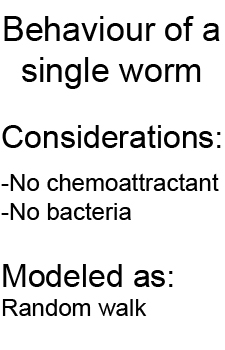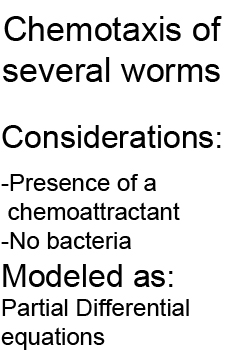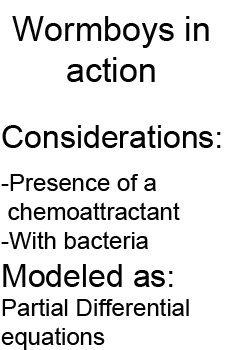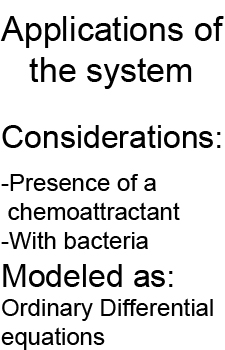Team:Valencia Biocampus/Modeling
From 2013.igem.org
(→Modeling) |
(→Modeling) |
||
| Line 26: | Line 26: | ||
<br>The movement of <i>C. elegans</i> in the presence of a chemoattractant in order to carry our bacteria to that source is the main issue of our project, so we consider modeling this aspect and employing it as scaffold for the whole modeling project. Several layers show up that it must be modeled in different ways. In our approach, we mathematically describe each layer, from the simplest to the most complex, integrating each one. | <br>The movement of <i>C. elegans</i> in the presence of a chemoattractant in order to carry our bacteria to that source is the main issue of our project, so we consider modeling this aspect and employing it as scaffold for the whole modeling project. Several layers show up that it must be modeled in different ways. In our approach, we mathematically describe each layer, from the simplest to the most complex, integrating each one. | ||
<br> | <br> | ||
| - | <br>The workflow is the following: | + | <br>The workflow in the <i>C. elegans</i> movement is the following: |
<br> | <br> | ||
<br> | <br> | ||
[[File:Primer_paso.jpg|150 px]] [[File:Segundo_paso.jpg|150 px]] [[File:Tercer_paso.jpg|150 px]] [[File:Cuarto_paso.jpg|150 px]] [[File:Quinto_paso.jpg|150 px]] | [[File:Primer_paso.jpg|150 px]] [[File:Segundo_paso.jpg|150 px]] [[File:Tercer_paso.jpg|150 px]] [[File:Cuarto_paso.jpg|150 px]] [[File:Quinto_paso.jpg|150 px]] | ||
| + | <br> | ||
| + | <br>The model is improved adding the data obtained from the experiments in order to achieve a holistic model which can predict the distribution of our worms, the kinetics of the present bacteria and the concentration of the substrate in each moment. | ||
<html> | <html> | ||
Revision as of 11:55, 14 August 2013
Modeling
The main goal in our modeling project is to accurately predict the behaviour of our system in several issues, from the mounting of bacteria on C. elegans to the performance of our worms reaching the place of interest. In order to do that, we use several modeling techniques.
The movement of C. elegans in the presence of a chemoattractant in order to carry our bacteria to that source is the main issue of our project, so we consider modeling this aspect and employing it as scaffold for the whole modeling project. Several layers show up that it must be modeled in different ways. In our approach, we mathematically describe each layer, from the simplest to the most complex, integrating each one.
The workflow in the C. elegans movement is the following:





The model is improved adding the data obtained from the experiments in order to achieve a holistic model which can predict the distribution of our worms, the kinetics of the present bacteria and the concentration of the substrate in each moment.
Biobricks modeling
In this section, clumping and PHA production are modeled and fitted to a equation. These things will be considered in other sections.
Clumping
PHA production
C. elegans behaviour
In the first place, we model C. elegans behaviour in the absence of chemoattractant and bacteria. When no chemotactic source is present, C. elegans moves randomly. This behaviour can be modeled as a random walk (Berg,1993) and can be simulated in several steps using a programming language, such as Matlab or R. Simulation is used to test the fiability of the model. The equations are the following:
Add equations
Simulations were performed in Matlab, proceeding as described in (Pierce-Shimomura et al., 1999). We contact with the authors but they could not provide us the code, so we developed our own script based on the article, obtaining similar results.
Add simulations
Chemotaxis of a single worm
However, we are interested in the movement of the nematode in a gradient of a chemoattractant. In presence of a chemotactic source, C. elegans moves in a similiar fashion as E. coli (Bargmann, 2006), a mechanism called the pirouette model (Pierce-Shimomura et al., 1999). Following this model, we defined the turning rate as a function of dC/dt. Simulations were performed as expected, showing a bias in the random walk:
Add simulations
Bargmann CI (2006) Chemosensation in C. elegans. Wormbook
Berg HC (1993) Random walks in biology. Princeton, NJ: Princeton UP.
Pierce-Shimomura JT, Morse TM, Lockery SR (1999) The Fundamental Role of Pirouettes in C. elegans Chemotaxis. The journal of Neuroscience, 19(21):9557-9569
Group behaviour
In practice, a single C. elegans is not employed to perform the task but a group of worms. In this case, the random walk equations obtained for a single worm behaviour can be transformed into partial differential equations (PDEs) to depict the distribution of the population, as the ones describing a diffusion process.
Mathematical demonstration of macroscopic RW as a diffusion process. Link?
The equations are the following:
PDEs
However, in our case we face a diffusion system with drift, in which the last term arises from the biased movement of C. elegans. To obtain a PDE that reflects this behaviour, we employed difference equations using Taylor series and apropiate limits
Mathematical demonstration of C. elegans chemotactic behavior using PDEs from biased random walk employing the pirouette model. Link? Propeties as mean or SD calculated from the equation?
PDEs. Parameters, as diffusion coefficient (D) or drift force (b) can be calculated form (Pierce-Shimomura, 1999)
Now, we can predict the behavior of a set of worms in presence of a chemoatractant. Simulations were run using Matlab. As seen, the distribution
Add simulation
Wormboys in action
Once defined the behaviour of a set of worms with no bacteria attached, we can model the action of microorganisms while they are riding C. elegans. In our model, bacterial substrate and worm chemoatractant are the same molecule, so it is consume while C. elegans is moving through the place. This alters the pattern of the molecule of interest, modifying the trajectory of the nematode. To take into account this feature of the system, a reaction term is added in the previous equation.
PDE
System performance
The main objective of the project is employing the equations to describe a new, theoretical, solid-batch biorreactor and comparing it versus liquid-batch biorreactor.
 "
"


